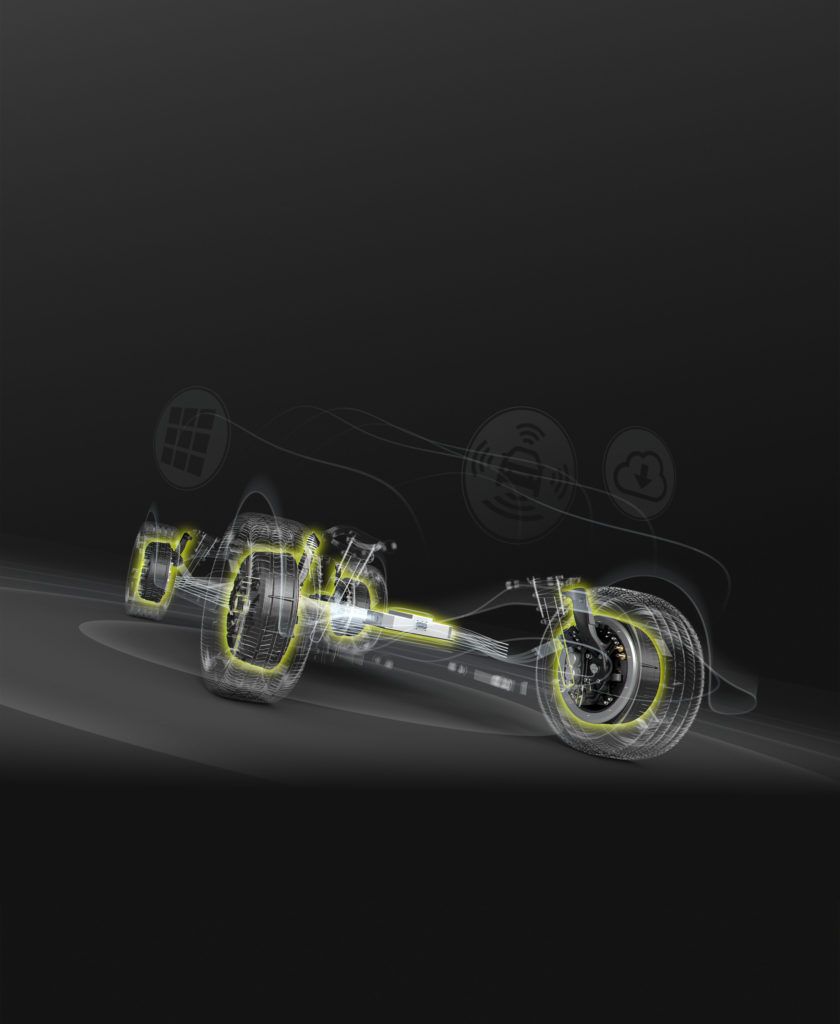Words Richard Gooding
Making its mark over a century ago, in-wheel electric motor (IWM) technology is nothing new. But the latest advances mean the terms ‘in-wheel motors’ or ‘e-axles’ aren’t strictly accurate. “Direct drive distributed architecture introduces key differences compared to an e-axle-based architecture,” states Gorazd Gotovac, CTO at Elaphe Propulsion Technologies. “Not only is unnecessary use of space and energy losses for transferring torque to where it is required, but the technology reduces the wheel actuator inertia to a minimum, enabling bi-directional control of the wheel/tire force with 15x the bandwidth of any other powertrain architecture. We need to stop talking about IWMs as just an electric powertrain type and start to talk about direct-drive architecture that essentially allows control of each corner independently, together with the vehicle-level opportunities it brings,” he says.
Elaphe’s implementation of direct drive allows generation of vertical motion of the whole vehicle simultaneously with horizontal motion (torque vectoring), using a completely standard geometry of passive suspension systems. It can control the ride of a vehicle purely by software which can be continually improved. “Modern in-wheel motor technology is not only a powertrain technology – it affects the whole vehicle in ways never before imagined,” says Luka Ambrozic, business development officer at Elaphe.
Electric platform company REE’s X-by-wire REEcorner technology isn’t a ‘traditional’ in-wheel set-up either. “The REEcorner is a standalone module that offers advantages from technological and economic standpoints including a precise ability to maneuver obstacles and difficult terrain,” says Peter Dow, vice president of engineering at REE. Other benefits include shorter service times, spare part inventory simplification, and tailored manufacturing processes. “The REEcorner technology integrates critical vehicle components like steering, braking, suspension, powertrain and control, into a single compact module between the chassis and the wheel, individually controlled via x-by-wire technology,” says Dow.

Packaging benefits
Protean Electric’s in-wheel technology consists of a motor, inverter and control integrated in a single package alongside a compatible friction brake, but whichever ‘in-wheel’ technology is described, the packaging benefits are the same. With powertrain components moved to the corners of the vehicle, interior space is freed up and with no electric drive unit (EDU) on the chassis itself, a flat floor offers more versatile space for passengers or cargo.
However, those packaging benefits can vary depending what kind of vehicle you’re working on, says Richard Ford, chief engineer at Protean. “If you start from the ground up, then it’s really amazing what you can do,” he says. “But most manufacturers aren’t yet willing to start from the ground up.” Ford says most of his current conversations are about how OEMs can see benefits with the addition of IWMs to their current electric or ICE platforms. “One of the major benefits is the ease of packaging into an existing platform,” Ford says. “Customers come to us when they want to have another driven axle.”
One such project was the Dongfeng Fengshen E70 4WD, the world’s first in-wheel motor driven homologated passenger car. The original car’s front wheels were driven by a central motor, but a pair of 78kW, 1,250Nm rear ProteanDrive Pd18 in-wheel motors add 4WD capability. “Even if one axle has a central motor and EDU, we can add a really convincing torque vectoring function on the other,” says Ford. “It’s quite a sophisticated tool to change a vehicle’s character in subtle ways. And, while torque vectoring traditionally is about on-limit behavior, changing a car’s agility is a much more useful torque vectoring function,” he continues. This collaboration led to the Dongfeng Voyah Zhiguang luxury sedan project which is designed to use in-wheel motors. Compared to two traditional e-axles, front and rear cabin space has been increased by 50% with an overall weight reduction of 104kg.
REE believes a ’right-sized’ approach is important in the design stages. “We have identified a growing need for mission-specific vehicles, especially in the commercial market where fleet operators want to tailor vehicles to their own specifications,” says Dow. “Efficiencies can be enhanced because vehicles can be precisely designed to meet end-use requirements. These can drive down total cost of ownership (TCO), potentially reducing the required number of vehicles in a fleet for substantial TCO advantages,” he reports.
Challenges the technology creates include today’s cost, as all ‘in-wheel’ technologies are not in large production volumes. Durability has also been cited as a disadvantage, but through appropriate technical design and automotive validation testing, this is now less of an issue. “One of the biggest differences to traditional architectures is that it positively affects so many parts and functions of the vehicle, it can no longer be designed in a ‘compartmentalized’ way,” says Gotovac. Functional safety is also a topic, which is gaining prominence with the rise of EVs and by-wire technologies. “In-wheel motor technology is a ‘powertrain by wire’,” Gotovac confirms, however, with no mechanical disconnects from the wheel, it becomes completely by-wire and software-defined. Gotovac believes it is an opportunity. “Controls can be developed that are seamlessly integrated end-to-end throughout the vehicle, leading to a better outcome for the vehicle performance and user experience.”
As unsprung mass is increased, the character of the system suspension and the way it works with a vehicle is changed, but Ford reports those issues are now in the past. “We did some work with Lotus, where a Ford Focus had the relevant amount of mass added onto the wheels and was then evaluated. Its summary was ‘yes, we can feel the effects, but with standard automotive suspension tuning, customers would not be able to feel the effect’,” he says. “One of the benefits of the REEcorner is that unsprung mass isn’t an issue because our motor is not in-wheel,” says Dow. “All the drive and actuation mass is contained within the corner subframe as sprung mass,” he continues. Safety also demands a high priority, and REE will implement redundancies in its technology. “It is key we implement our x-by-wire safely and we have every intent to ensure we meet the highest safety standards,” Dow says.
 ‘Right fit’ segments
‘Right fit’ segments
The light commercial vehicle market is one of the most logical and ‘right fit’ segments for the technology, says Dow. “Right now, we are seeing the most opportunity in vehicle Class 3-5, with impactful solutions for fleet owners and drivers,” he says. REE’s modular platform allows for tophat configurations, and its P7 EV light truck chassis is built on top of four 100kW REEcorners and can be powered by 126 or 168kWh batteries – supplied by partner Microvast – or fuel cells.
“The use of IWMs on light commercials offer benefits including a low step height,” says Ford. “Most electric LCVs with e-axles have to have the ride height increased by a decent amount, and with light commercials, particularly last mile applications, it’s all about step height,” he says. Adding IWMs to an existing ICE or hybrid application to enable it to drive into clean zones in city centers using IWMs is an easy way to electrify a fleet. “That’s a nice way, without significant investment, to achieve clean air targets without the step height increase compromise,” Ford continues.
Autonomously driven shuttle pods are another area in which in-wheel motors have a clear role. “A decade ago, everyone thought by now we would all be ride-hailing, and in-wheel motors are made for those,” says Ford. Benefits include full north-south-east-west vehicle access and a flat floor. “It’s a no-brainer and while that market doesn’t seem to be coming towards us very quickly, it’s probably still in the future,” Ford believes. “While most of our business has piqued the interest of last-mile delivery customers building out EV fleets, the REE platform also has autonomous capabilities which are being utilized for driverless transport systems in Europe and the Middle East,” Dow reports.
How far into the future IWM technology may start to challenge traditional electric powertrains is a little unclear. But that threat is on the horizon. “Central motors probably won’t be displaced for many years,” says Ford. “IWMs may have a small percentage of the next generation platform in 2025 to 2032. We’ve got a few hurdles to get over but once it is understood these are not real problems and we get volume, cost will come under more control,” he continues.
Ambrozic is more bullish. “If the question is when – the answer is now. We are already helping develop the first ‘next-gen’ platforms based on direct-drive architecture. But as with any superior technology, introduction will be gradual and through specific markets,” he says, with low-volume models arriving first.
“In-wheel-based direct drive architectures have fundamental advantages in enabling ultimate vehicle safety, comfort abilities and personalization of the vehicle driving character, so growth is expected in segments where brands compete in these areas,” says Steve Lambert, head of electrification at McLaren Applied. “With third and fourth-generation platforms in development, more models (especially those with increasing ADAS capabilities) will be launched on in-wheel architectures. As IWMs, for various reasons, reduce complexity of the architecture, platforms become almost wholly software-defined; the focus on SW controls is going to dictate the speed of adoption,” he says.
SiC: Efficiency Savior
The arrival of silicon carbide (SiC) technology will benefit the in-wheel motor sector through its efficiency benefits, not only on the drivetrain, but on the entire vehicle. More efficient switching produces less heat, enabling a smaller cooling system, reducing the drivetrain weight and cost. McLaren Applied’s new IPG5 800V SiC inverter can power electric motors to over 350kW peak, 250kW continuous, and has been chosen by Elaphe to create the next level of efficient, power- and torque-dense, and high-bandwidth direct drive drivetrains.
“When you take into account the weight savings, you start to see decreased power and energy requirements, which means you can then further optimize the system,” Lambert says. “It is this virtuous cycle that comes about from utilizing SiC in combination with in-wheel architecture that allows designing and optimizing a vehicle around efficiency as well as SW-defined driving character. We expect most vehicles to be using 800V and SiC by the end of the decade and the move towards efficiency will happen in parallel to the move towards 800V fast charging technology,” he adds.
Breaking New Ground
The benefits of IWM technology are maximized when a ground-up approach is taken. SAAB successor NEVS’ (National Electric Vehicle Sweden) experimental Emily GT electric sedan was designed to showcase this approach. Powered using four of Protean’s IWMs, the project was created in just 10 months. “It was an extremely compressed timescale,” says Ford. “There were lots of compromises, but the cockpit is enormous,” he confirms. Ford reports that couldn’t be achieved with two traditional EDUs at the car’s front and rear and states the obvious: ‘If you take the EDUs away from the middle of the axle, moving them into the wheels, you end up with space.”
Challenges creating the 480hp machine included fixing the design and systems very early in the program. “The chassis and interior had to be made, with all the powertrain and high-voltage components, and because those systems interact with each other, they had to be fixed at a really early point in the program so design activity could start,” Ford reports. “The NEVS project team did a fantastic job.”





